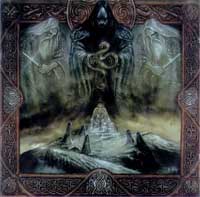Absu
Fast American black metal band in the old school style like Slayer or Sodom, with added varying clean vocals and different types of song structures.
Barathrum: Visita Interiora Terra Rectificando Invenies Occultum Lapidem
Gothic Records
|
1993
|
|
|
Production: Distant and muddied, fairly flat but there is little fidelity to damage.
Review:
Texan metal is usually either very speed/heavy metal, or sounds like Swedish death from the late eighties. Absu combine the two elements, sounding like a Scandinavian death metal band with a black metal ideal and some death metal adaptations in the Western hemisphere style (a good band to compare in terms of approach would be Hypocrisy, who have a similar mix of influences but a different take on the aesthetic of them).
The music is played quickly, with a melodic line running behind some dark riffs. Death metal comes in in the riff structure, which follows the standard all-phrasing little tonality idea that most of that genre embrace, but in the melodic undertones and dark cadences there is potent black metal, something reinforced by the unearthly high-end scream laid down as a vocal track.
Riffing is distinctive pattern shuffling out of the simple elements of power chords, although it mirrors some ideas of (oddly enough) speed metal, in the rhythmic and recursive aspects. Nothing here that Slayer hasn't done better, and it leaves the album somewhat unsatisfying.
Tracklist:
1. An Involution of Thorns
2. Descent to Acheron
3. An Equinox of Fathomless Disheartenment
4. The Thrice Is Greatest to Ninnigal
5. Infinite and Profane Thrones
6. Fantasizing To The Third of The Pagan Vision
7. An Evolution Of Horns
Length: 30:52
|
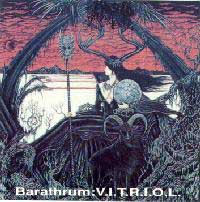
Copyright © 1993 Gothic
|
Overall a good album if you like stuff like Bestial Warlust, Blasphemy, Impaled Nazarene or other simple grindcore- and deathmetal-influence black metal bands. The added vocals, female and male, and the strange ceremonial nature didn't do it for me as the music sounded like the same core elements I've heard so often, slightly rearranged and dressed in a tribal format. I like this stuff for what it is but it lacks the profundity of Scandinavian releases, both in musical and aesthetic arrangement.
|
The Sun of Tiphareth
Osmose
|
1995
|
|
|
Production: Steely literal production captures the distant but representative sound of the band in a low volume but high vocal-fidelity environment.
Review: Epic black metal stylings encompass a heart of older style metal, with an album reminiscent of Slayer's early work in the structural creation of each song and the rhythmic metastyle used to hold these riffs together into song. Absu's gritted-teeth vocal scream and chanted recitations melt into the background swimming with strumming rhythm repeated over chord and melody shift: the evil shuddering speed of nervous deconstruction.
Tracklist:
1. Apzu
2. Feis Mor Tir Na N'og (Across the North Sea To Visnech)
3. Cyntefyn's Fountain
4. A Quest Into the 77th Novel
5. Our Lust for Lunar Plains (Nox Luna Inlustris)
6. The Coming of War
7. The Sun of Tiphareth
Length: 43:11
|
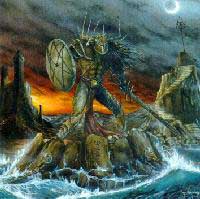
Copyright © 1995 Osmose
|
The nature of embellishment on most metal records as a chance to show off the keyboards in the name of "open-mindedness" contrasts egregiously the diligent integration of certain choice paganistic intros, clean guitar parts in the folk style, and insertion of non-guitar instruments that occurs here. A risky line was towed with this method of retro-metal in its search for a quest and a sound; underneath aesthetics it is not dissimilar to other black metal and death metal bands in the populist school of atonality, but with some careful structural work and liberally applied good taste, Absu have brought out the structural finesse within the genre.
Well-paced work muscled with rippingly fast chord groups and single-string speed strumming drives along probing structures while vigilant drumming nails out violent processions of morbidly entropic beats, keeping the obscurity high as tension over the dominant vibration of guitar. Any atmospheric or ambient effects to this music come from the flutterstrum of the guitar, which mediates the articulation of the riff under the dominant chord change, allowing a greater degree of inflection; its mesmerizing cyclic tendency hypnotizes with linear voicings of complex rhythms broken into a datastream of fast picking. With a combination of the black metal primal mysticism, death metal nihilism and the gothic theatrics of a horror show, this band not only use themselves to throw an image at the listener but make solid ripping death/black metal as well.
|
The Third Storm of Cythraul
Osmose
|
1997
|
|
|
Production:Ashen and distant but representative.
Review: Metal traditions of three generations come forth in the third release by US black metal band Absu. Combining the vocalcentric approach of early evil heavy metal bands with the frenzied vibrations of high-speed frenzystrum bands like Slayer while integrating the riding percussion and vocals of a modern black metal band, Absu bash out communicative music that rocks along nicely while solidly iterating its simple, violent missives. Without ever peaking any new frontiers in metal or music Absu bring a closure to many of these styles, a historical fixation that at its core might be something like Mercyful Fate but might also contain the historical work of other evil metal pioneers Slayer, Morbid Angel, Bathory.
Perhaps best understanding this music comes from outside analysis of its anti-function: deconstructive but affirmative music coded in simple but pointedly nihilistic terms to suggest a return to an era of mythos when existence beyond common objects meant more than first-world feeding festivals of valueless sustenance.
Tracklist:
1. Prelusion to Cythraul (6:48)
2. Highland Tyrant Attack (4:58)
3. A Magician's Lapis Lazuli (3:08)
4. Swords and Leather (3:07)
5. The Winter Zephyr (3:00)
6. Morbid Scream (2:10)
7. Customs of Tasseomancy (3:28)
8. Intelligence Towards The Crown (1:56)
9. Of Celtic Fire, We Are Born (8:33)
|
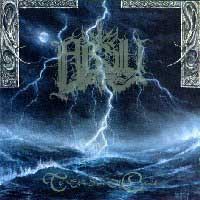
Copyright © 1997 Osmose
|
Streams of powerchords imbued with sub-rhythm in the hummingbirdwing strum roll into snare-stamped, chord-grounding positions which finalize the violent rhythm of the meme (per song, per part of song) which defines the violence apart from others. Lead guitars wail psychotic but understate their understanding of the music, leaving the pyrotechnics for almost cynical interpretations of tradition and common mentality.
Drums dart and strike outside of the cage of rigid rhythm backing these musically dogmatic phrases, but with enough internal offset to nourish counter-complexity in all subelements in awareness of all others. This percussion foils the overbearing need for guitars to return to conclusion from wandering speed riffs, but joins in chorus increasing as the song culminates. Of all the things arrayed here, the interplay of song sustenance (percussion and guitar rhythm) against song meme (vocal and main percussive rhythm) reveals how well Absu orchestrate their songs: the melodrama apparent on the cover functions in the aesthetic of their creations, songs built on the foundations of metal to play out its classical issues: mortality, destiny, determinism, and the soulless nature of the forces of goodness in comparison to the lawless, ordered, chaotic impulse from the side of darkness.
|
In The Eyes of Ioldanach
Osmose
|
1998
|
|
|
Production: Older school production captures a flat wall of sound that is clear but does not give as much room to the higher-speed modern riffing as one could hope for.
Review: Massively influenced by Slayer, this latest release from the boys from Plano continues their progression toward articulating their aggressive and death metal-based approach to the mystical genre of black metal, evolving their music both toward a more centrally structured approach in the newer atonal style and an older-school integration of fairly random riffs to a core rhythm and vocal melody. While the heritage elements of this music remain the chorus-based structuring and vocal melodic centering, the divergence is in ambient structures of high-speed dissonant variation, hiding within the center of otherwise more conventional pieces attributes of the nihilism of black metal.
Tracklist:
1. VITRIOL
2. Hallstatt
3. Manannan
4. Never Blow Out The Eastern Candle
Length: 17:30
|
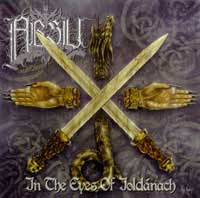
Copyright 1998 Osmose
|
Most impressively these songs are executed with higher speed and precision than previous Absu works, with more intricate lead riffing allowing them to use structures of shifting resolution to create stepped spaces through which they can enter any of the other passages in a song, allowing a cyclic recombinant phraseology that empowers the micro-riff variations the band uses to emphasize shadow variations on the primary melodic progression in each song. To support this percussion rolls through bursts of polyrhythm into gradually decomposing riffing returning to the driving energy which powers each song with tempos of massive speed and a complexity derived from growth of simple independent functions within each beat, alluding to while not aesthetically referencing the frenetic power of a computer-administrated world.
As expected from past releases, the heavy influence of older King Diamond shows in the chorus patterns and heavy metal-style riffing interlaced with the death metal on this release, as well as in the abundant flourishes of demonic vocals squirted from the drying vocal chords of a vocalist squeezed between competing rhythms of the same rubric within each piece. Overall coherence and the essence of directed but unpolarized art are much enhanced on this release, making this reviewer conclude that it is the highest point of evolution Absu have yet attained.
|
|
|
|
Production: Spacious and clear sound.
Review: Retrieving the operatic style of dark metal from a generation ago Absu bring to it turbulent speed drumming and racing tempos in wristrip of riff which facilitate the drama of a poetic nature in these songs. In the sense that the poetic can be defined as meaning a changing sequence of moods which through their position indicate resolution, this release creates poetry through not only varying technique across songs but varying mood in songs.
The foundation of this style is Mercyful Fate or Judas Priest at the "frenetic space of modern metal" with a foundation in self-recursive dissonant phrasing. Mostly lead riffing or standard power chords configured in streams of melody fill out the themes and dramatic interchange of moods to these long-format songs. Drums at a lightning pace instantiate fills or maintain a drive that while not based in the total nihilism of blasting approaches it in complexity and immediacy of confirmation to spatial motion. In the style of previous albums, emphatic metals and snare at the pace of a running humans in terror accompany the line drive of most phrases, and here drumming advances further by knowing when simplicity and background work balances its accompaniment more than flash. Yet its drive is central to the energy of the music and its chaos is unleashed barely within the bonds of rationality for the sake of esoteric fills.
Quoting influences ranging from Led Zeppelin to Swedish death metal, the album moves from safer territory toward the more ecclectic and ambitious pieces for which this band are known, and in those moods recreates an essential and primitive quality to human existence. Fear and passion are linked in the praise of adventure and sensuality in harrowing transfers of emotion and violence that are comforting in the context of their participation in an adventure. Like a journey, the album introduces itself in intensity and then drops to contemplative dynamics before resuming the charge for its unsettling confrontation.
That this vocalist can range from an exacting black metal shriek to a flesh and blood reproduction of the sickening screech of Ronnie James Dio, and these musicians can follow at lightning speed any schematic of fast black metal in the context of their unique take on classic metal with current technique, is secondary to the spirit with which they execute their dramatic symbolism. Epic and reflexive in its nihilistic predictions this work delivers its core in concept and music and then withdraws into fading Celtic music.
|
BLACK | DEATH | HEAVY | SPEED | THRASH | GRINDCORE
Copyright © 1988-2004 the Dark Legions Archive
|





